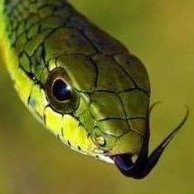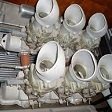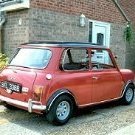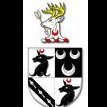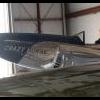Search the Community
Showing results for tags 'AMT'.
-
My first model car kit has been completed, with an attempt to make this car have the same color theme as my 91 base model. This car is equipped with the iconic LT5 engine, designed by Lotus, manufactured by Mercury Marine. It has a six-speed manual. The C4 Corvette was produced from 1984-1996, but the ZR-1 was produced from 1990-1995. When the ZR-1 came out in 1990, it was different than the standard Corvettes by having different front and rear fascia, MUCH wider front and rear tires, and a third brake light above the rear window hatch (as well as ZR-1 badging). But for the 1991 model year, the ZR-1 specific body upgrades were applied to the base model (except the third brake light), making the base and ZR-1 somewhat identical. This is one of many C4 Corvette model kits AMT released throughout the 80's/90's. It has been a long process to build this (almost a year), but mostly due to time constraints. If I rushed, it might have taken me about one month. The fit of some parts is unacceptable (engine, rear axle, hood height) and modifications were required to make the model look its best. If I wasn't fond of having duplicates with differing colors, I would NOT build another. The color has been painted using a custom color (Turquoise) from https://www.splash-paints.com/, and also used their 2k clear and black primer. I am extremely happy with the results, even though the color isn't a 100% match to the real GM code 42U. The interior has been painted black, like mine. In the 1:1 car, some plastic panels are actually very dark gray, but since the rest of the interior is black, it wouldn't make much of a difference when viewed from the outside. All paints except the body color have been airbrushed using Vallejo Model Color. Enough of the history and process, let's see them pictures! Images are raw and straight from camera with no post-processing (because the color is that good!). Interior photos and the WIP can be seen over on this thread ---> https://www.britmodeller.com/forums/index.php?/topic/235129204-amt-ertl-1991-chevrolet-corvette-zr-1/ If there are any issues about the info above, please let me know! All the history was done from memory. Thanks for viewing! AJ
- 12 replies
-
- 28
-

-

-
In order to ensure I am not missing the forest for the trees, let me present what I have come up with so far and the reasoning behind it. With the announcement of HK Models 1/48th scale A-20B/C kit, I decided to focus on my AMT kit which I spend quite some time detailing. Looking at the nacelles, it didn't seem to correspond with the text in various books about the fourteen exhaust ejector pipes being divided by five under fixed cowl flaps on the outboard side, four under the fixed cowl flaps on the inboard side with the remaining six under formed movable cowl flaps. Note that, instead of six formed ejector pipe covering cowl flaps, one nacelle has seven! So, I decided to look at the manuals illustrations and photographs. I need to state that I don't trust restorations, particularly those for flyable examples, as concessions on accuracy are made for safety and/or convenience. Let's start with the port side - One clearly sees five exhaust ejector pipes under the fixed cowling followed by a plain movable cowl flap, another formed to cover a pair of exhaust ejector pipes, and a gap before we see another formed shaped: While I don't trust flyable restorations, this one has open cowl flaps showing the same port side and the orientation: Inner side of port nacelle showing two pairs of exhaust ejector pipes under their respective movable cowl flaps: Also seen in a training film: Now, the starboard side from outer to inner - Period photograph showing seven formed movable cowl flaps: Here we see that under the fixed cowl flap, we see an open movable cowl flap formed to cover a pair of exhaust ejector pipes, followed by a plain movable cowl flap, and then another covering a pair of exhaust ejector pipes. Barely visible is a gap and the shape of a formed flap: From the rear, the TM illustration seems to show only four exhaust ejector pipes under the fixed cowl flap (contradicting the text of the books): Reverting to the non-flyable restored example, we see the continuation: Photo taken from the inner lower side of the starboard nacelle shows (continuing from the outboard), a blank movable cowl flap, a pair formed one, a single formed one, and another pair formed one. Completing the tour, we see that there are three exhaust ejector pipes under the inner fixed cowl flap: So, this is what the kit provides meaning that it is correct all along and the expensive 1/32nd scale HK Models kit is not: Trying to figure out how HK Models got it wrong on their 1/32nd scale kit (and hopefully will be corrected on their 1/48th scale kit), one simply has to look at the Lewis Flying Air Legends' example: HK Models 32nd scale kit and they copied this, along with the inaccurately sized nose wheel from the museum example, perfectly! Port side: Starboard side is VERY strange as they seem to have four exhaust ejector pipes under each fixed cowl flap with the remaining six in the same orientation as the port side. Red dots indicate the open exhaust ejector pipe ends: So, have I lost my bearings? Let me know.
-
Long-time lurker posting in RFI for the first time, yay!😄 I have had this kit for a looong time (even the all-knowing .xls says "before 2004", best guess is mid-1990s), half-built, but could never bring myself to tossing it; somehow, I got inspired last year to pick it from the Box of Shame, and I managed to finish it just before the year ended. The ship is the Klingon adversary of Cpt. Kirk & Crew in only a few episodes of the very first Star Trek series. Fit of the kit is mediocre (as is typical of AMT kits from the late 1960s), and decals are limited to insignia and a few Klingon letters. No windows, of course (why should the Klingons have it any better than the Enterprise Herself) except for a few holes that had to be filled anyway. I replaced the transparent-green, riffled phaser banks to the left and right of the cobra head by something built from cut-up styrene tube that looked closer to the original. Since the kit had been in the Box of Shame from a time when I still used everything as a filler but real filler, there was some work to do, and tiny holes would appear at inconvenient times and places during sanding. The contraption for hanging the model from the ceiling and the holes for the Z-shaped stand were closed up and replaced by a single styrene tube for the base. Windows were researched online, but no absolutely consistent sizes or patterns could be found, even though there are only two original miniatures, both of which are in museums and are supposed to look exactly like manufactured. So I picked what looked plausible to me. Round windows were punched from black decals, square windows were created by cutting up rows of rub-on letters ("I"s and "1"s mainly) and transferring these to decal sheet - I was afraid that I would not be able to keep consistent sizes when cutting ~50 rectangular shapes from black decal. Colours are Tamiya XF-21 (Sky) and XF-23 (Light Blue) mixed 1:1 for the green, and XF-56 (Light Grey) for the upper surface grey. The metal effect was created by spraying XF-56 (Metallic Grey) and drybrushing with XF-16 (Matt Aluminium). I decided not to weather the kit at all - ships are quite clean in the Star Trek universe, and TV resolution was so coarse that all the miniatures were clean anyway. The Klingon base is a resin piece that I picked up at starshipmodeler.com ages ago; there is a gazillion tiny bubbles, which I had no wish to clean up, so I sprayed it all with semi-gloss black primer, inserted a piece of brass tube and called it a day. Might paintbrush the Klingon insignia and lettering with Future later to pick them out in gloss black.
-
A hangover from a past group build, this one sat because I wasn't happy with the wheels and tyres. I thought I'd started another thread in here since, but I can't find it, so here we are... Original thread: I was planning to use a set of Halibrand kidney bean wheels from an original issue kit, but they looked a bit undersize and I didn't have any tyres that looked right. Since I bought a 3D printer, I've spent many more hours drawing things than building, but it has produced some tangible results. I drew the early lip/bead laced 5.5x15 wheels and 6.40-15 front and 6.70-15 rear tyres, as fitted to the earliest cobras and still on CSX2000. Test print - a few spokes didn't make it, so tweaks needed.
-
I came so close to getting this done for the Above the Karmen Line GB last year, but not close enough, and thus brought great shame on the House of No Mac. However, the time has come to start swinging the bat'leth again. The story so far: https://www.britmodeller.com/forums/index.php?/topic/235128786-klingons-on-the-starboard-bow-amt-bird-of-prey/ SitRep: There's not a huge amount left to do. First, it's badly in need of a dusting. Second, the painting of engine part needs revisiting and refining. Third, the scratchbuilt cannons really need some extra greeble-age as they're looking pretty plain, also I'm expecting the removal of the masking tape will cause some grief paint-wise. Fourth, some fine detail painting here and there. Five, fix the display stand and figure out a more sturdy base. And so my battle with this AMT kit resumes. May the spirit of Kahless also guide you as you battle your KUTA entries. Qapla’!
-
I've been working on this kit alongside the AMT 1967 Shelby GT350, primarily because I didn't want to airbrush the same color twice. I got this kit (and started modelling) to make this specific model kit, to TRY to match my real car (my Vette has the base engine). So far about 90% of all parts have been painted, assembly will start soon. The body has been sanded and is ready for primer alongside the Shelby GT350. It will be painted just like my car, Metallic Turquoise. As there is very few polished items on this vehicle IRL, I decided to paint all the chrome parts steel, with a few exceptions. I have seen a few examples of C4 Corvettes with polished rims, but mine has the alloy rims. So I decided to paint the rims as well. The interior and the engine will be assembled first while I wait for the weather to let up so I can prime the body. The interior will be black with dark grey dash and center column.
- 34 replies
-
- 10
-

-
With the weather being so good this weekend, and the Micra paint drying I figured it was worth making a start on another car I've, well not owned as such but which shares a name with one I've owned. So step forward AMT's 1965 Pontiac Grand Prix. The pic below shows what's in the box (sort of), although there are two chrome sprues in that chrome bag. Lots of extras in there too, the vast majority of which I probably won't use. Definitely one of those kits where the box art is doing its best to put you off buying it - I get that the front picture represents the original box art but wish that when you see these on sale they would included the one picture of a stock car which exists on the box. I haven't unwrapped the glass, chrome or wheels for the shot above as it's going to be a long time before I get around to building it. But I do want to get it sprayed this summer, and maybe one after this, so might as well make the most of the good weather. In terms of first impressions, they're not that great I'm afraid. A couple of pieces have come loose from the sprue, and some parts (especially the interior tub) have a fair bit of flash going on. And then I thought about it for a minute and it occurred to me that the tooling for this kit is older than I am, so I think it's fair to see it's not aged too badly. Naturally, first job (after washing it) is to tidy up the mould lines. Fortunatelt not too much flash on this kit, but some of the mould lines were a bit awkward to get to. It also hasn't got a panel line between the bonnet/hood and windscreen for the sides of the scuttle panel which should be there on the real car. I cut lines in with a #11 scalpel to try to get a straight line, then widened and deepened with the scriber. It was only after I thought about using masking tape to get a straighter edge but this will do I think. Certainly better than nothing. The bracing bars between the front wings weren't too bad to remove though, and this is what it was like before I sprayed the first coat. I thought I had picked up the imperfections, but as usual an application of primer highlights the bits I'd missed. As I was using the grey Halfords primer though, I could use the first layer as a guide coat to when I sanded back those remaining issues. After that I gave it a proper priming. Looking much tidier now. Have to say though that this thing is huge - even though it's 1/25 and thoretically a smaller scale than most of the models I've done it still swarfs everything else, even the Jag XJ220. It's likely to be into next year before I finish this, but thanks to all who've looked at the start of this one.
- 112 replies
-
- 10
-

-
A 23 Squadron Boston III nightfighter to be built from the AMT kit
- 36 replies
-
- 14
-

-
As far as classic US muscle cars go, I am pretty much a MoPar fan. The AMT kit of the 1970 Super Bee ticked a few boxes for me, spurring a recent purchase. This variant of the Dodge Coronet was only available for a couple of years and culminated in 1970 with a styling change, most notably the front grille, this was now configured into the shape of outstretched Bumble Bee wings, very pretty! Unfortunately the kit is a bit of a mish-mash of different boxings. Apparently, the body shell is derived from the mould used to produce the 'Annual kit'. If I recall correctly, these were simplified, built up, model cars that the salesman would present to little Johnny when his Dad picked up his new car. I chose yellow and black because.... Well, it's a Bumble Bee innit !! 😉 The black bonnet is non-standard but I've seen a few real cars sporting this, I like the look. Mmm, last year I built the AMT 68 Roadrunner (Pro-Stock version) This was not too bad and went together ok. Now, the 70 Super Bee kit shares a floor pan, suspension, and engine with the Roadrunner, problem is, none of those parts fit into the Super Bee body 😱 The body was painted, foiled, decalled, clear coated and polished. The interior was completed and the chassis and drive train all fully built up. The instructions do tell you to modify the front side windows to clear the dash. Had to laugh really and did wonder if anyone at AMT had actually put this thing together! The side windows were sawn up as I just wanted to put the rear glass in, to show the door glass wound down. Test fit again, now the interior will not fit!! Side glass in the bin.🤬 The interior is a little bit narrow for the body, also very shallow. It's not clear from the pic but the bottom of the steering wheel is actually lower than the top of the driver seat! I'm now starting to get into the realms of 'just want to get this thing finished'. Anyhoo, I finally wrestled the parts together and ,apart from the missing side glass, the end result is not too bad. I did make a few changes, the door handles and windscreen wipers were chiseled off and replaced with white metal items. Door locks simulated with 1mm rivets. The wheels and tyres are from a Revell 32 Ford. Headlights drilled out and replaced with aftermarket items. (I really dislike the moulded in chrome headlamps) Final pic is of the Revell 69 Super Bee and the AMT 70 Super Bee together. This highlights the difference between 1/24 and 1/25 scales, more obvious in such a large car? Atb, Steve. The Ram Air induction scoop on the bonnet is just clipped in place. It doesn't actually fit over the air cleaner. The 440 'Six-pack'. I have added ignition wiring and heater hoses. The moulded in wiring is highlighted with a fineline paint pen. You can just make out the rear side window, ready to fit. This didn't last long. The flat spots on the tyres look terrible here, but they do help to create the illusion of a car having weight.
- 24 replies
-
- 32
-

-

-
Hello all, I started this build about 3 weeks ago, and it's coming along nicely. I started making car models because I wanted to model my car, but I only wanted to use an airbrush. So alongside that model, I got this GT350 model as well to practice on off of eBay. It was open box, and I thought everything was there, but it wasn't complete as I thought it was. The only missing part was the two taillights. I have two options; buy the taillights off of eBay for 7 USD (not including shipping, which is about 1/3 of what I paid for the open box kit itself), or download a free GT350 model and 3D print just the lights. I plan on 3d printing the missing part and using the money to get the paints. I also realize the tires that came with the kit are somewhat contradictory to the instructions. The tires should have been open on both ends, but instead I got... I'm going to have to figure out how to get the wheels mounted. Also, what is the best way to remove rubber flash? So far, I have the chassis and engine completed, as well as the basic construction of the body. The interior parts are about to be primed right now. My plan is to paint the body Acapulco Blue, and using all the stripes that came with the kit. The body before primer. Going to need a bit of modeling putty. I plan on using Vallejo paints for everything but the body. I will be using Splash Paints for the exterior. If anyone has a problem viewing these images, let me know. It's my first time embedding images on a forum.
-
Completing my trio of P-40's for the GB, and last in line alphabetically, comes the K. This is another internet purchase that came as a bag of bits mostly still attached to their sprues, except for the main parts, instructions and a set of decals that look about as reliable as anything that comes out of Putin's mouth. The bag of bits; I thought this came as an E but should have read what is on the bag more clearly, E/K/M from the same kit? Now the front of the E/K/M and N are pretty much the same at the front of the fuselage being all Allison powered variants, but the rear of the fuselage is a different matter, the F/L/M and N all have a stretched rear fuselage. What I have in the bag is a stretched fuselage so that leaves it being an M as the canopy on an N is different and the F/L are Merlin powered so the front of their fuselage is different. There are however the parts for the tail of a K and all that is required to turn an M into a K is the correct tail and a little bit of surgery. AMT got the most of their moulds by giving you different parts to add to the kits and also requiring a bit of surgery in some cases. A result of this is a slight mismatch where the tail joins the fuselage which can be tricky to clean up and keep the details depending on how bad your kit is (they vary from being a good match to an awful one) mine isn't brilliant but thats okay as I'm chopping it off anyway, this is the rear fuselage as it comes; And here it is after surgery with the replacement K tail complete with the fin fillet usually associated with the variant, though they didn't all have this distinctive feature, the P-40 family can be a tricky subject! The parts actually fit quite well and a bit of sprue goo will sort things out nicely. Now onto the markings and the reason for the movie related title. In December 1942 the squadrons of the 57th FG began painting their unit badges on the noses of their aircraft and the badge for the 64th FS was a scorpion so a lot of their aircraft began to look like the one in the profile below; That picture actually illustrates the difference in length of the rear fuselage between the E/K and the F/L/M/N. This is a different camo scheme from my other P-40's which appeals too me greatly, a bit of variety is a good thing. I have some decals for this aircraft by Superscale but they are way off on the size of the numbers and some other details too so I will have to look into sorting that out. So that completes my P-40 triumvirate, all that remains now id to actually build them! Thanks for looking in and as usual all comments and criticisms are gratefully received. Craig. 🇺🇦
- 113 replies
-
- 22
-

-
I finally completed this build today. This kit started life as an Italeri boxing of the AMT AC-130H. The conversion involved: Plugging the 'AC' holes Lengthened the fuselage for and aft of the wing Adding AE2000 engines from Jen's Bits Adding various parts from the Hamilton Hobbies conversion set. Scratch building the Satellite Wifi dome Scratch building various antennas modified the long range tanks with chaff dispensers Added a Litening pod from Quickboost/Eduard It was finished using SMS, Gunze and Tamiya paints and decaled using the Southern Sky C-130J-30 decal sheet.
- 4 replies
-
- 35
-

-

-
- AMT
- conversion
-
(and 1 more)
Tagged with:
-
Looks like I am dragging this one out of the stash from a few years ago. I did start it with grand plans to show it in a take-off pose so I chopped up the wings Got as far as test fitting wing parts and I think the cockpit has been painted. But I think I will revisit it to see if some sprucing up is required. I am using a Caracal decal sheet for an RC-135V and I will be robbing the engines from a KC-135R to make it a current version. The decals are for this jet and I will attempt a similar pose.
- 11 replies
-
- 18
-

-
HI everyone!🙂 this is my 1/25 AMT '67 shelby GT-350 this kit got some issues..I try to build it as good as I could.. not perfect...but I am happy with this result.. hope you guys like it!🙂
- 24 replies
-
- 36
-

-
Hi All, here is a completed '40 Ford Coupe I received as a Christmas present (from my in-laws). Its built using the parts for drag use, though whether it would pass scrutineering for class AA/G is another matter! The kit is a Round 2 re-pop of an AMT kit that has been around from the 60s. It seems to be a favourite of US car modellers, from what I can see on YouTube. I built a few US car kits when I was in my early teens and such things were easily available in the UK at Beatties stores. I had forgotten the period features of variable mouldings and being given a set of parts that it was up to you how they fit together. The colour is a custom mix of orange and copper, approx 2:1 using Tamiya paints and a W&N acrylic gloss finish (which now needs a month or so to go properly hard). The colour is more orange in daylight. I had to rebuild the blower intake as the parts were somewhat short-moulded. The Moon tank was made from the gas tank the instructions suggested could go behind the seats, which on reflection is probably safer than at the point-of-impact as I've modelled. Well, I hope you all like this slice of Americana. I'm off to "recover" with a Hase Stratos... Cheers Will
- 15 replies
-
- 20
-

-

-
This one came from the bay as 'missing parts'. Well the price was right but it's the Barris version, so it's ugly. What to do? Search the spares boxes and forget historical authenticity. It's a restomod. Make it up as you go along! It's taken a while due to life/lack of time and the cold weather getting in the way. But here we are at last... The George Barris version has a different front end so no Pontiac split grille I found a Cadillac grille in the spares box which, with fettling, just about fits. That meant I had to lengthen the hood (bonnet) the join is almost invisible, but the hood isn't a perfect fit. In my haste to get it finished and photgraphed this afternoon I forgot that I hadn't put a wash into the grille. Drat! It doesn't go up into the front of the fenders here which are supposed to surround the original stacked pairs of lights. So I've put a gob of Elmers glue in to fill the holes and I'm calling them riding lights. I've seen quite a few real restomods on TV where they strip the chrome and paint the trim body colour. So aside from the quarterlights (I forget the American term) which the Molotow pen coloured in, it's all blue. It's a Ford blue BTW. Hycote acrylic rattle can. Nice stuff. And I haven't added clear. This is 'scale shine'. Rear lights and bumper were missing. So it's a spares box bumper and Thunderbird tail lights. And that's yer lot. It's not perfect but I enjoyed it and it will join the others that have survived the years. I bought quite a few car kits back in the '90's when they were very cheap, and built them when I worked in Riyadh. I had lots of spare time back then, sigh... The WIP is here https://www.britmodeller.com/forums/index.php?/topic/235115814-amt-65-lowrider-grand-prix/ I still need to finish the '70 Impala. We'll see what life and the weather have to say about the speed of that! Thanks for looking. I hope you found something to like. Pete
- 20 replies
-
- 22
-

-
This will easily be the biggest vacform I've ever attempted, and it's daunting if I'm honest. Picture of the real one below, I'll post pictures of the kit later with something to scale it against Edit Thanks to the diligence of a fellow BM member @Shorty84aka Markus, I discovered the BV238 needs significant alterations to end up anything like the original aircraft so an alternative was required. I've chosen to build the 1/72 Valkyrie instead, I hope you like it. Cheers Pat
- 58 replies
-
- 22
-

-
And the news for us Star Wars fans just keeps getting better and better! Now AMT is bringing out a 1/72nd scale Razor Quest from the Mandalorian TV show. No more word about it than this placard on display at WonderFest this weekend. So, Revell has already announced they're doing one in 1/72nd as well. And there's also the Bandai one - but that looks a very small kit from the imagery thus far. Is AMT's a reboxing of Revell's? Is Revell's just for the European market as was their Republic Gunship? In any event, a 1/72nd Razor Crest is hella cool! https://www.scalemates.com/kits/amt-razor-crest--1355671
-
This kit's directions have a note that I started putting paint to plastic on July 16, 2020 and I finished the model July 5 of this year. During that time, I did manage to complete one other model that had been set aside (Tamiya Meteor Prototype Number One), and also started two other kits, so the entire year wasn’t devoted to this one…but it felt like it! 😉 I deviated from the instructions somewhat. The main landing gear has five attachment points and the directions would have you fish that assembled, multi-part landing gear up through the wheel well opening. I couldn’t see me getting that done without some big trouble. So, the assembled gear were installed through the top of the engine nacelles (much easier!) and then the nacelles were installed on each wing before they were attached to the fuselage. Of course, that meant they were in the way for the rest of the build. I did cover them with protective “spats” that I made from paper towel tube, and they made it through without any issues. I had really wanted the model to sit on her three wheels without the support of the kit-provided barrel and crate, used in real life Tigercat service to keep the front tire on the ground when fuel tanks were empty. So, I added a lot of ballast into the fuselage, all forward of the main gear centerline. I knew that much weight would surely stress the plastic kit landing gear, so I used a set of white-metal gear instead. The total weight of the ballast was over 75 grams and I just knew it would be enough. I was wrong. 😦 The P&W R-2800s supplied in the kit were quite nice and I added spark-plug wiring and few other small parts that are pretty hard to see now. I didn’t use the notorious rubber tires that came in the kit, instead using a resin set in their place. Eduard PE seat belts were used and I scratch-made the canvas “sling” that served as the rear cockpit seat. The kit props are really misshaped, so I robbed an old Monogram Hellcat and Avenger of their props and used them. Paint was ModelMaster Insignia Yellow matte, and I used a semigloss clear-coat over that to replicate the somewhat glossy yellow paint used on the Naval Air Test Center bird from 1947 that I was doing for this build. I've found only one photograph of this NATC aircraft and it shows heavy exhaust staining, with black soot blown back along the nacelles and wings. Man, they must’ve been running those R2800s mighty rich! I wish I could have airbrushed that soot, but I just didn’t trust myself to do that without messing up the paint work, so it was done with pastel chalks. I was hesitant to seal the chalk staining with a clear-coat, so it was left unsealed and I was careful not to touch it after application. I also used some Flory wash to highlight a few panel lines. I deleted all the guns as the reference photo shows none and I added two, small sensors seen in that pic to the sides of the nose. I worried a lot about getting the tires all installed with the flat bottoms actually on the bottom, and still keeping them plumb. It is a difficult model to handle, so I laid her upside down on a jig and used 30-minute 2-part epoxy to attach them to the metal gear stubs. Turning her over and setting it over the table, I adjusted and checked them several times and felt they were good to go. Next morning, I sat her on her “feet’ for the first time ever and found that all three weren’t plumb. Their flats were on bottom but there was no way at that point to adjust them vertically without catastrophic consequences so they are what they are I’m afraid. And, I fear they may splay out more as time goes by with all that weight on them. And even with all that weight, she's still a tail-setter without some support of her rear-end. Since I ended up needing the barrel and crate anyway, I should’ve not used any weight at all! Live and hopefully learn. 😀 I took her to the Cameron airport on Tuesday, July6, for a photo session. All in all, I guess she looks okay; not as nice as I wanted but it’ll have to do. Thanks for hanging in this far, and thanks for your interest too. As always, I welcome your comments! Cheers! 🍻 Here's a shot of the front cockpit before it was all closed up: Rear cockpit photo: An early pic of the engines without their cowlings: Cockpits on finished model: This is the only photograph of the real NATC Tigercat I could find: My model in a similar pose:
- 36 replies
-
- 75
-

-

-
My entry will be the original ground attack aircraft of the Second World War, which was the precursor of the Stuka - the Henschel Hs 123. I happen to have this kit in the stash for some time, so the group build is a great opportunity to clear at least one kit from the stash.. The AM Tech kit is actually the rather venerable ESCI kit from the 1970's, but has added resin goodies to do the cockpit. I intend to do this in the Spanish markings that come with the kit, which is of one of the aircraft that was retained by Franco's Nationalists after the Civil War, and the markings on the kit are from the aircraft in 1945. The Scalemates information on the kit is here;- https://www.scalemates.com/kits/amtech-489203-henschel-hs-123a-1--120433 I have also purchased the Montex Maxi mask for this kit, which allows me to spray the various national insignia and tactical markings, instead of using most of the decals. I will be beginning in a week or two. Philip
-
What do the letter codes mean? My nephew has a old model kit from his great uncle and he wants to know what the letters mean for which paint colours. The kit was made in 1983 apparently and.... WOW!!! It tells you how to assemble it but barely. There are no numbers and there is no chart telling what paints to use just letters.
-
Start of a old AMT kit ,dod a bit of the office [under 25%] Thats it so far. Wellzy
-
Hi folks here is my first entry in to the GB - Kittyhawk IV RAAF flown by Squadron Leader Geoffrey Atherton. It is the old AMT kit of the P-40N Warhawk but i have markings from an Italieri boxing that allows me to build this version. I have a set of AM resin wheels and an etch set for the Hasegawa kit that may or may not fit, we shall see... Anyway here are some images of the kit etc theres no box art as i bought it off a BM member in the sales area without a box. TFL Cheers Greg
-
Finally calling this one done, 1/1400 AMT Klingon Vor'Cha cruiser, hand painted in humbrol enamels. Colour scheme from DS9. 30 year old decals given a coat of decalcote before use. No disintegrating decals, yeah and a localised matt cote to seal them. Picked up a good tip, scan a copy of your decals to your computer before use, just in case, then if need be print a set off. As builds go this was a sweet build, no fit issues or filler required, which is a surprise as previous AMT larger scale Star trek builds have been woeful. A word to the wise, if your contemplating getting one, pick up a first issue as the painting guide is more in depth than the Vorcha re-release which leaves a lot of the detail painting out, whose instructions you can download from round 2. All the best Chris
-
About 10 years ago now, I built an antique 1:72 Revell Ju 88C-6. This was partly a nostalgia build, and partly an exercise in adding a bit of detail. I also practised trying to get a mottle with a hairy stick. It was no masterpiece, but I was pleased with it and it's still sat in my display cabinet. Fast forward 10 years and I decided to build another Ju88C-6, but this time using AMT's kit. I wanted another crack at trying the mottle. I basically built it oob, then sprayed it Tamiya RLM76 from a rattle can and added the mottle using a new method. Here is the result, with a comparison pic with the classic build. Another step on the way to a decent mottle finish. Rgds Martin
- 10 replies
-
- 40
-

-
- 1:72
- Classic Revell
-
(and 1 more)
Tagged with:



